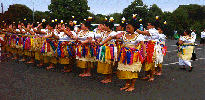You are here:
- Home >
- Pacific Education 2020–2030 >
- Polyfest NCEA credits
Polyfest NCEA credits

About Polyfest
With almost 10 000 performers every year, Polyfest is New Zealand’s largest cultural event where thousands of school students perform music and dance from an array of cultures, Held regionally across Aotearoa, and culminating in a three day event in Auckland, the even features cultural performance talents in a competitive and community-focused environment. More importantly, Polyfest fosters student agency and leadership, collaboration across all levels of the school, and a chance to connect with culture and community.
For those students who participate – and for the teachers and community members who help them – performing at Polyfest is hours of work.
Converting hours to NCEA credits
Now, those hours of work can be translated for students into NCEA credits The assessment often involves students being filmed performing in a group. Schools assess students against NCEA achievement standards in the arts. Students are assessed on factors including dance choreography, movement, technique, and coordination.

Students can achieve credits in year 11, 12, and 13 in achievement and unit standards the teacher choses. For example, year 12 students can gain credits under the achievement standard Dance 2.4: Perform a theatre dance to communicate understanding of the dance.
Some standards schools can use
Many schools use a level 2 standard: 2.3 Perform an ethnic or social dance to communicate understanding of the style and a level 3 standard: 3.4 Perform a group dance.
The repertoire standards – 2.5 Perform a repertoire of dance and 3.5 Perform a repertoire of contrasting dances - were specifically written for this type of performance. These standards offer appropriate credit value for the amount of work involved in being part of a festival performance.
Videos featuring Polyfest and academics

Connecting Polyfest with academic performance
Pacific students discuss the importance and relevance the ASB Polyfest has played in their classroom learning, which in effect improved their academic achievement.
Key points in this story include:
- how senior students mentoring younger students (known as the tuakana / teina model)
- the celebration of culture by engaging with their traditional performing arts
- ways students are able to connect their cultural identifiers to Pacific giftedness.
In this video clip, Tagata Pasifika's Marama T-Pole (née Papau) talks to Manu Faaea-Semeatu about Polyfest.
Manu details how Polyfest allows students to gain credits towards their NCEA
More thinking about NCEA pathways

Choosing your own path through NCEA
Kristan Mowat, Head of Media Studies at Logan Park High School, describes how her school empowers students to set goals and make choices.
Students are supported to make choices about their learning pathways through flexibility with NCEA internals and externals and through finding standards that match their interest and needs.
Use this video to support your school’s curriculum decision-making about learning pathways.
Vocational Pathways
From learning to earning – to help your students see real-world connections between NCEA standards and real-world industries, check out Vocational Pathways.
The six Vocational Pathways are: Creative Industries, Primary Industries, Service Industries, Social and community services, Construction and Infrastructure, Manufacturing and Technology.


